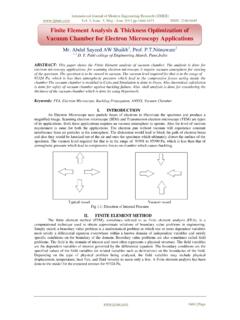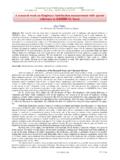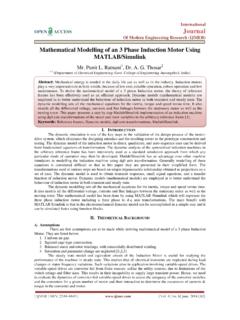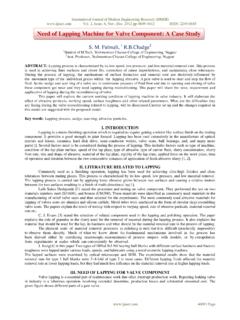Transcription of Analysis and Design of Transmission Tower
1 International OPEN ACCESS Journal Of Modern Engineering Research (IJMER) | IJMER | ISSN: 2249 6645 | | Vol. 4 | Iss. 1 | Jan. 2014 |116| Analysis and Design of Transmission Tower Gopi Sudam Punse I. INTRODUCTION Transmission Line Tower India has a large population residing all over the country and the electricity supply need of this population creates requirement of a large Transmission and distribution system. Also, the disposition of the primary resources for electrical power generation viz., coal, hydro potential is quite uneven, thus again adding to the Transmission requirements.
2 Transmission line is an integrated system consisting of conductor subsystem, ground wire subsystem and one subsystem for each category of support structure. Mechanical supports of Transmission line represent a significant portion of the cost of the line and they play an important role in the reliable power Transmission . They are designed and constructed in wide variety of shapes, types, sizes, configurations and materials. The supporting structure types used in Transmission lines generally fall into one of the three categories: lattice, pole and guyed. The supports of EHV Transmission lines are normally steel lattice towers . The cost of towers constitutes about quarter to half of the cost of Transmission line and hence optimum Tower Design will bring in substantial savings.
3 The selection of an optimum outline together with right type of bracing system contributes to a large extent in developing an economical Design of Transmission line Tower . The height of Tower is fixed by the user and the structural designer has the task of designing the general configuration and member and joint details. The goal of every designer is to Design the best (optimum) systems. But, because of the practical restrictions this has been achieved through intuition, experience and repeated trials, a process that has worked well. Power Grid Corporations of India Limited has prescribed the following steps to. Opt i m i ze d t he De si gn of P owe r T ransm i ssi on L i nes:- o Selection of clearances.
4 O Insulator and insulator string Design . o Bundle conductor studies. o Tower configuration Analysis . o Tower weight estimation. o Line cost Analysis and span optimization. o Economic evaluation of line. ABSTRACT: In this thesis Analysis and Design of narrow based Transmission Tower (using Multi Voltage Multi Circuit) is carried out keeping in view to supply optimum utilization of electric supply with available ROW and increasing population in the locality, in India. Transmission Line towers constitute about 28 to 42 percent of the total cost of the Transmission Lines. The increasing demand for electrical energy can be met more economical by developing different light weight configurations of Transmission line towers .
5 In this project, an attempt has been made to make the Transmission line more cost effective keeping in view to provide optimum electric supply for the required area by considering unique Transmission line Tower structure. The objective of this research is met by choosing a 220KV and 110KV Multi Voltage Multi Circuit with narrow based Self Supporting Lattice towers with a view to optimize the existing geometry. Using STAAD PRO v8i Analysis and Design of Tower has been carried out as a three dimensional structure. Then, the Tower members are designed. Analysis and Design of Transmission Tower | IJMER | ISSN: 2249 6645 | | Vol.
6 4 | Iss. 1 | Jan. 2014 |117| Figure Transmission line Tower LITERATURE REVIEW Research paper Y. M. Ghugal , U. S. Salunkhe [1] Analysis and Design of Three and Four Legged 400KV Steel Transmission Line towers : Comparative Study Applied Mechanics Department, Govt. College of Engineering, Aurangabad Maharashtra (India), Post Graduate Student of (Structural Engineering), Applied Mechanics Department, Govt. College of Engineering, Aurangabad. International Journal of Earth Sciences and Engineering 691 ISSN 0974-5904, Volume 04, No 06 SPL, October 2011, pp 691-694 Abstract: The four legged lattice towers are most commonly used as Transmission line towers .
7 Three legged towers only used as telecommunication, microwaves, radio and guyed towers but not used in power sectors as Transmission line towers . In this study an attempt is made that the three legged towers are designed as 400 KV double circuit Transmission line Tower . The present work describes the Analysis and Design of two self-supporting 400 KV steel Transmission line towers viz three legged and four legged models using common parameters such as constant height, bracing system, with an angle sections system are carried out. In this study constant loading parameters including wind forces as per IS: 802 (1995) are taken into account. After Analysis , the comparative study is presented with respective to slenderness effect, critical sections, forces and deflections of both three legged and four legged towers .
8 A saving in steel weight up to resulted when a three legged Tower is compared with a four legged type. V. Lakshmi1, A. Rajagopala Rao [2] EFFECT OF MEDIUM WIND INTENSITY ON 21M 132kV Transmission Tower Assistant Professor, Civil Engineering, JNT University Kakinada, Andhra Pradesh, India, Professor of Civil Engineering (Retd) JNT University Kakinada, Andhra Pradesh, India, ISSN: 2250 3676 Volume-2, Issue-4, 820 824 Abstract: In this paper the performance of 21M high 132kV Tower with medium wind intensity is observed. The Recommendations of IS 875-1987, Basic wind speeds, Influence of height above ground and terrain, Design wind speed, Design wind pressure, Design wind force is explained in detailed.
9 An Analysis is carried out for the Tower and the performance of the Tower and the member forces in all the vertical, horizontal and diagonal members are evaluated. The critical elements among each of three groups are identified. In subsequent chapters the performance of Tower under abnormal conditions such as localized failures are evaluated. The details of load calculation, modeling and Analysis are discussed. The wind intensity converted into point loads and loads are applied at panel joints. , , Babu [3] Behavioural Analysis of built up Transmission line Tower from FRP pultruded sections Central Power Research Institute, Bangalore, India , National Institute of Technology Karnataka, Mangalore, India ISSN 2250-2459, Volume 2, Issue 9, September 2012 Analysis and Design of Transmission Tower | IJMER | ISSN: 2249 6645 | | Vol.
10 4 | Iss. 1 | Jan. 2014 |118| Abstract: The power Transmission line towers will have to be built with new Design concepts using new materials, reduction of construction costs and optimizing power of delivery with restricted right of way. This paper discusses experimental studies carried out on a X-braced panel of Transmission line Tower made from FRP pultruded sections. Mathematical model of individual members and members in the X-braced panel are generated using FEM software to study the analytical correlation with the experiments. The member stresses are monitored using strain gauges during full scale testing. Conclusions are drawn based on these studies.















